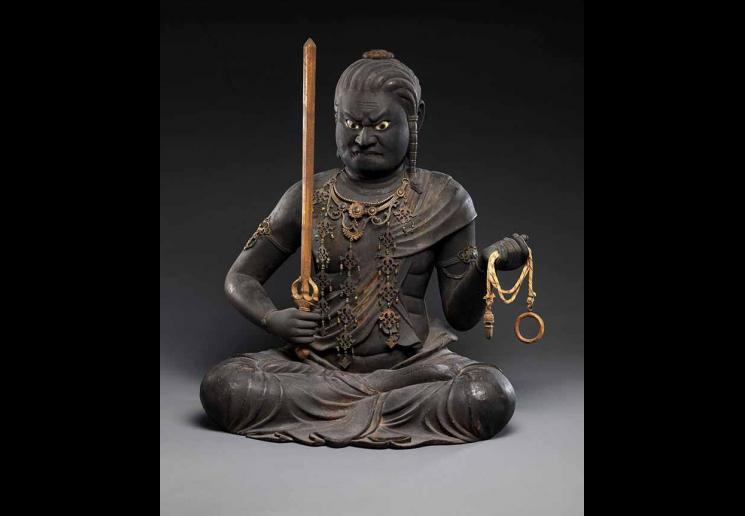The magnificent sculpture of the Kamakura period (1185-1333) has long been considered a high point in the history of Japanese art. Stylistic and technical innovations led to sculpture that displayed greater realism than ever before. Sculptors began signing their works, allowing us to trace the development of individual and workshop styles that influenced later generations for centuries. Religious developments – often combinations of traditional and new practices – brought devotees into closer proximity with the deities they worshipped. It is an important period in the development of Japanese Buddhist art.
Buddhist Sculpture from the Kamakura Period (1185-1333)
The icons in this exhibition commanded the faith of passionate devotees, some of whom hoped to gain merit from the making of a Buddhist image, to ensure salvation in the afterlife, or to obtain tangible benefits in this life. Others aimed to achieve ultimate awakening through ritual unification with the deity represented by the icon. In their original contexts these powerful icons were ‘real presences’, brought to life by their naturalistic form, ritual activation, and sacred interior contents.
Craftsmen created these icons during a time of profound political and social disruption. For the first time in Japanese history, powerful warrior clans challenged the imperial court that had dominated the political and cultural landscape for centuries.
Great Buddhist Temples of Nara
In the civil war of the 1180s, the great Buddhist temples of the ancient capital in Nara burned to the ground. The devastation shocked the entire country, but rebuilding and repopulating the temples with new sculptures and paintings began almost immediately. Renewed contact with the Asian mainland, which flourished in the early Kamakura period, further invigorated arts and religious practices.
Elite warriors became an important new source of patronage for religious arts, while the imperial court and aristocratic clergy continued their sponsorship of sculpture workshops in Kyoto and Nara even as their fortunes gradually declined. One major new patron was Minamoto Yoritomo, who became the first ruling shogun and established a military government headquartered in the town of Kamakura in eastern Japan.
Threat of Invasion by the Mongol Empire
Later in the 13th century, however, the continued threat of invasion by the Mongol empire created further instability. In 1333, a cunning Japanese emperor launched a rebellion ending the Kamakura shogunate less than 150 years after its founding.
Despite the brevity of this historical period, it had a lasting impact on the political, artistic, and religious legacy of Japan. Shoguns and warlords were the dominant rulers up until the mid-19th century. Even in the 18th century, sculptors proudly traced their artistic lineages back to early Kamakura master sculptors, while religious movements established during the period continue to be some of the most popular forms of Buddhism practised in Japan today.
Kamakura Period Sculpture Strikingly Realistic
Kamakura sculpture can be strikingly realistic; the works have naturalistic body proportions and are carved with a sense of breath-filled volume. Buddhas (enlightened beings) and bodhisattvas (beings destined for Buddhahood who postpone it to assist others in reaching enlightenment) appear approachable, while fierce guardian deities possess a great sense of movement and dramatic facial expressions. The folds of draperies and details of clothing are rendered with convincing naturalism, and facial features often evoke real, human individuals.
Several factors contributed to the increased realism in sculpture of the period: joined-woodblock construction (employing multiple hollow blocks of wood for a single statue) allowed sculptors to portray more dramatic movement than in works carved from a single tree trunk.
The Use of Inset Crystal for the Eyes
The use of inset crystal for the eyes was another important innovation that created a vivid sense of realism. Sculptors in the Nara area, working to restore icons lost to fire, revived and updated naturalistic eighth-century styles. Contact with China intensified during the early Kamakura period, and Japanese sculptors absorbed elements from Song-dynasty (960-1279) Chinese art, which also displayed greater naturalism during this time.
Master Sculptor Kaikei (active 1183-1223)
The Kamakura period saw the emergence of master sculptors with clear artistic identities. We know the names of these artists from signatures on works, a practice which increased significantly in this period. The standing Shaka Buddha, Fudo Myoo, and Standing Jizo Bosatsu in this section were all made by the master sculptor Kaikei (active circa 1183-1223), one of the most renowned artists of the period, whose style was widely imitated by later sculptors. Kaikei developed a sophisticated form of sculpting that was followed by artists of later generations. Kaikei, whose date of birth and death are unknown, has been seen as an equal to Unkei (d. 1223), whose father is said to have served as the young Kaikei’s teacher. The artist carved out Buddhist images as a serious devotee of Amida (Amitabha), which can best be indicated by the Standing Amida Nyorai still at Todaiji temple in Nara.
Competition for patronage was fierce, and artists completed commissions for a wide variety of patrons and religious institutions. But as inscriptions and documents reveal, sculptors were also themselves devotees of Buddhism and of the deities they so beautifully rendered in material form.
Despite the brevity of this historical period, it had a lasting impact on the political, artistic, and religious legacy of Japan. Shoguns and warlords were the dominant rulers up until the mid-19th century. Even in the eighteenth century, sculptors proudly traced their artistic lineages back to early Kamakura master sculptors, while religious movements established during the period continue to be some of the most popular forms of Buddhism practiced in Japan today.
Until 8 April at Asia Society, 725 Park Avenue, NY 10021, www.asiasociety.org











